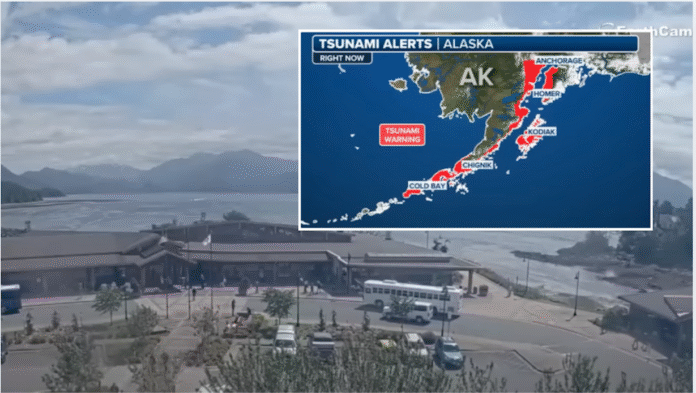- A powerful 7.3 magnitude earthquake struck near the Shumagin Islands in southern Alaska. It triggered a tsunami warning and mass coastal evacuations.
- Sirens, emergency alerts, and visible ocean retreat caused widespread panic. Shelters opened, and residents fled to higher ground across affected areas.
- The tsunami threat was later downgraded. However, over 20 aftershocks followed, prompting continued caution and raising concerns about future seismic risks.
A powerful earthquake shook Alaska’s southern coastline on Wednesday. It sent thousands of frightened residents scrambling for safety. The tremor, which measured 7.3 on the Richter scale, struck just after midday. It triggered a tsunami warning that sparked chaos in towns across the region. Panic set in as sirens blared, phones buzzed with emergency alerts, and entire communities fled to higher ground. They feared the worst.
The quake, centered in the Pacific Ocean near the Shumagin Islands—southeast of Sand Point—was so strong it rattled buildings. People were momentarily frozen in fear before the reality of the tsunami threat set in. From Homer to Unalaska, a stretch of nearly 700 miles, the message was clear. It was time to evacuate now.
Sirens, Panic, and the Race for Safety
Within minutes of the quake, emergency sirens pierced the air, and social media lit up with messages. These messages urged residents to leave coastal areas immediately. Roads leading out of low-lying neighborhoods were jammed as families loaded into cars. Some had pets, children, and emergency bags hastily thrown together.
“We had bumper-to-bumper traffic on the spit,” said Homer Mayor Rachel Lord, describing the frantic exodus. “People weren’t waiting around—they knew what to do and they moved fast.”
Scenes from across the state painted a surreal picture. In Sand Point, the ocean pulled away from the shore, leaving the beach eerily dry. This was a classic and terrifying sign that a tsunami might be incoming. The stillness was broken only by the sound of sirens and the rush of people heading uphill. They were desperate to escape any possible waves.
Tsunami Confirmed, Then Downgraded
Officials soon confirmed that a tsunami had indeed been generated, with the U.S. Coast Guard reporting a three-inch wave near Sand Point. Although the initial impact was minimal, the threat was taken seriously.
David Snider, a tsunami coordinator with NOAA, confirmed the wave’s presence and urged caution. For about 90 tense minutes, communities waited anxiously. Then, just before 1 p.m. local time, the tsunami warning was downgraded to an advisory—and eventually canceled altogether.
But that didn’t mean the danger was over.
“Some areas may still see unusual sea level changes,” warned the Tsunami Warning Center. “Please remain alert.”
Officials advised coastal residents to stay cautious throughout Thursday, as aftershocks could continue and unpredictable waves might still arrive. And they did—more than 20 aftershocks were recorded by the Alaska Earthquake Center, the strongest registering at 5.2 magnitude.
Schools Become Shelters, Tourists Caught in Chaos
With fear spreading, emergency shelters were quickly opened in places like Kodiak, one of the largest towns in the affected zone. Also, North Star Elementary and Kodiak High School began taking in evacuees.
In Seward, a port town on the Kenai Peninsula, one woman documented her escape on video. She had just returned to Alaska after 25 years away—only to be greeted by a tsunami threat. Her voice shook as she filmed herself walking away from the beach with a group of others.
“Just pray we don’t get waved,” she said nervously, before cutting off the video.
Alaska: America’s Earthquake Capital
Experts weren’t surprised. Michael West, a leading seismologist with the Alaska Earthquake Center, told Fox Weather that Alaska is no stranger to violent seismic activity.
“Four out of five earthquakes in the U.S. happen in Alaska,” he explained. “The entire southern coast is one huge fault line.”
Though most of the quakes are small and go unnoticed, Wednesday’s quake stood out. “It’s not the biggest we’ve seen, but it’s significant,” West said. “And judging by the lack of serious tsunami damage, we’re on the lucky side today.”
The National Weather Service confirmed that there was no tsunami threat to states beyond Alaska. Coastal residents in Oregon, Washington, and California were spared this time.
A Haunting Reminder of Past Disasters
For many Alaskans, Wednesday’s quake stirred painful memories of past disasters—especially the historic 1964 Good Friday Earthquake. That monster quake, measuring 9.2 in magnitude, remains the most powerful ever recorded in U.S. history. It devastated coastal communities and unleashed deadly tsunamis that reached as far as Japan.
By comparison, Wednesday’s earthquake may have caused less damage. However, it brought back the raw fear that Alaskans live with every day. A 7.3 quake is no small event. When paired with tsunami sirens and evacuations, it becomes a terrifying ordeal for those in its path.
In King Cove, a small fishing town with under 900 residents, officials moved fast. Alerts were issued urging everyone in low-lying areas to head uphill. For the tight-knit community, many of whom live near the water, the scare hit especially close to home.
Relief Turns to Reflection
By evening, as the advisory was lifted and people began returning home, there was a sense of both relief and exhaustion. Social media was flooded with posts of gratitude. People expressed appreciation toward first responders, local officials, and neighbors who helped each other during the panic.
But there was also a sense of unease. Many questioned if Alaska was truly prepared for the next “big one.” Others were frustrated over the unclear communication at certain points during the alert. This was especially an issue in remote towns where cell service is spotty.
Still, most agreed on one thing: the community response had been swift, and the drills and emergency planning had paid off.
“I’d rather run for nothing than stay and risk everything,” one Kodiak resident wrote on Facebook. “I’ll take false alarms over funerals any day.”




